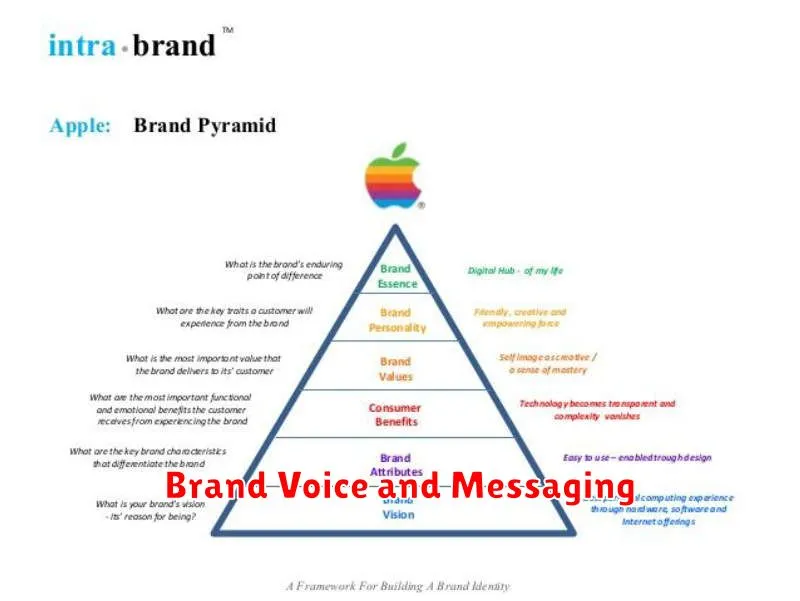In today’s competitive market, a compelling brand strategy is paramount to success. It serves as the blueprint for all your marketing efforts, guiding how you communicate your value proposition, differentiate yourself from competitors, and connect with your target audience. Developing a strong brand strategy requires a deep understanding of your business, your customers, and the market landscape. This understanding allows you to craft a unique brand identity that resonates with your audience, builds loyalty, and ultimately drives growth. Without a well-defined brand strategy, your marketing efforts can become fragmented and ineffective, leading to wasted resources and missed opportunities.
This article will delve into the essential components of creating a compelling brand strategy that delivers tangible results. We will explore key aspects such as defining your brand purpose, identifying your target audience, crafting your brand message, and developing a visual identity that reflects your brand values. By understanding and implementing these crucial elements, you can build a powerful brand that stands out from the crowd, attracts loyal customers, and achieves long-term success. Whether you are a startup or an established business, this guide will provide you with the insights and tools necessary to create a brand strategy that drives meaningful growth.
What Is a Brand Strategy?
A brand strategy is a long-term plan for the development of a successful brand in order to achieve specific business goals. It’s a roadmap that guides all brand-related activities, ensuring consistency and clarity across every touchpoint.
This plan encompasses elements such as brand positioning, messaging, target audience, and the overall brand experience. It defines what the brand stands for, its unique value proposition, and how it should be perceived by the market. A well-defined brand strategy informs every aspect of a company’s marketing and communications efforts, leading to a cohesive and impactful brand presence.
A key component of a brand strategy is understanding the competitive landscape. By analyzing competitors, a company can identify opportunities to differentiate its brand and stand out in the market. This analysis informs decisions about pricing, product development, and marketing campaigns.
Ultimately, a strong brand strategy fosters brand loyalty and recognition, ultimately driving business growth. It provides a framework for making consistent and effective decisions that contribute to the long-term success of the brand.
Why Your Brand Needs a Plan
A well-defined brand plan acts as a roadmap for your business, guiding your decisions and ensuring consistent brand representation. It provides clarity and direction, aligning your team and all marketing efforts towards a common goal. Without a plan, your brand message becomes diluted and ineffective, leading to confusion in the marketplace and potentially hindering growth.
A strong brand plan allows you to differentiate yourself from competitors. By identifying your unique value proposition and target audience, you can craft messaging that resonates and establishes a clear competitive advantage. This focused approach helps you attract and retain customers, ultimately driving business success.
Consistency is key to building a strong brand. A comprehensive brand plan ensures consistent messaging, visuals, and experiences across all platforms. This cohesive approach builds trust and recognition with your target audience, strengthening your brand identity and fostering customer loyalty.
Having a brand plan facilitates growth. By defining your target audience, marketing strategies, and key performance indicators, you can effectively measure and track your progress. This data-driven approach allows for informed decision-making and adjustments to your strategy, maximizing your potential for growth and market share.
Brand Voice and Messaging

Brand voice is the personality a brand conveys in its communications. It encompasses the tone, language, and overall style used to connect with the target audience. A consistent brand voice builds recognition and fosters a stronger connection with consumers.
Brand messaging, on the other hand, refers to the core message a brand communicates to its target audience. This includes the value proposition, key benefits, and overall brand story. Effective brand messaging clearly articulates what the brand stands for and why consumers should choose it over competitors. It should be consistent across all platforms and touchpoints.
Developing a distinct brand voice and messaging requires careful consideration of the target audience, brand values, and competitive landscape. A well-defined brand voice and messaging framework ensures that all communications are aligned with the overall brand strategy.
Defining Core Values
Core values are the fundamental beliefs that guide a company’s actions and decisions. They serve as the foundation for the brand and inform everything from product development to customer service. Clearly defined core values are essential for building a strong and authentic brand.
Identifying core values requires careful introspection and consideration of what truly matters to the organization. These values should be more than just buzzwords; they should reflect the company’s genuine beliefs and aspirations. They should be meaningful, memorable, and actionable. Consider what principles drive the company’s behavior and what distinguishes it from competitors.
Once identified, these values should be clearly articulated and communicated both internally and externally. This ensures that everyone within the organization understands and upholds the core values, and that customers understand what the brand stands for. This consistency helps build trust and loyalty.
Examples of core values might include integrity, innovation, customer focus, or sustainability. The specific values will vary depending on the industry and the individual company’s mission and vision.
Building Emotional Connection
A compelling brand strategy hinges on fostering a strong emotional connection with the target audience. This connection transcends mere product satisfaction and delves into the realm of shared values, aspirations, and beliefs. By understanding the emotional drivers behind consumer choices, brands can craft messaging and experiences that resonate deeply.
Building this connection requires authenticity and consistency. Brands must clearly define their core values and ensure that every touchpoint reflects those values. This builds trust and fosters a sense of community around the brand.
Storytelling is a powerful tool for creating emotional connections. By sharing compelling narratives that align with the target audience’s values, brands can evoke empathy and build stronger relationships. These stories can highlight the brand’s origin, mission, or the positive impact it has on the world.
Understanding the customer journey is crucial. Identifying key emotional touchpoints throughout the customer experience allows brands to tailor their messaging and create personalized interactions that deepen the connection.
Logo, Colors, and Visual Identity
A compelling visual identity is crucial for brand recognition and differentiation. This encompasses your logo, color palette, typography, and imagery. These elements work together to create a consistent and memorable brand experience.
Your logo serves as the face of your brand. It should be unique, memorable, and reflective of your brand’s values and personality. Consider its simplicity, scalability, and versatility across various mediums.
Color psychology plays a significant role in brand perception. Carefully select colors that align with your brand’s message and evoke the desired emotions in your target audience. For example, blue often conveys trust and stability, while red can represent excitement or passion. Document these choices in a brand style guide for consistency.
Typography choices also contribute to your brand’s personality. Select fonts that are legible and reflect your brand’s style, whether classic, modern, or playful. Maintain consistency in font usage across all brand materials.
Competitive Positioning
Competitive positioning defines how your brand uniquely stands out from competitors and occupies a distinct space in the consumer’s mind. It’s crucial for attracting your target audience and building a sustainable competitive advantage.
Understanding your competitive landscape is the first step. Analyze your competitors’ strengths, weaknesses, target audiences, and marketing strategies. Tools like SWOT analysis and perceptual mapping can be valuable here. Identify gaps and opportunities in the market that your brand can capitalize on.
Choosing the right positioning strategy is essential. Do you aim to compete on price, offering the most affordable option? Or will you focus on differentiation, highlighting unique product features or a superior customer experience? Perhaps your strategy involves focusing on a specific niche market.
Once established, your competitive positioning should be consistently communicated across all brand touchpoints, from your website and marketing materials to customer service interactions. This consistency strengthens brand recognition and reinforces your desired brand image in the market.
Internal Brand Alignment
Internal brand alignment is the process of ensuring that all members of an organization understand and embrace the brand’s values, messaging, and positioning. It’s a critical component of a successful brand strategy, as it empowers employees to become effective brand ambassadors. When everyone within the company is on the same page, it fosters consistency in brand representation across all customer touchpoints.
Achieving internal brand alignment requires clear communication and ongoing training. Employees need to understand not only what the brand stands for but also how their individual roles contribute to the overall brand experience. This can involve workshops, internal communication campaigns, and readily accessible brand guidelines.
Aligning your internal teams creates a unified front, strengthening the brand’s impact on the market. This internal understanding fosters authenticity, which resonates with customers and builds trust. Ultimately, a well-aligned internal team contributes significantly to a compelling and successful brand strategy.
Brand Audit and Updates
A thorough brand audit is essential for understanding your brand’s current position. This process involves a comprehensive review of your brand’s visual identity, messaging, target audience, and competitive landscape.
Key areas to examine include your logo, color palette, typography, website, marketing materials, and social media presence. Analyze how these elements align with your brand values and resonate with your target audience. Assess your brand’s strengths, weaknesses, opportunities, and threats (SWOT analysis).
Based on the audit findings, identify areas for improvement and update. This may involve refreshing your logo, refining your messaging, or adjusting your target audience. Updates should be strategic and aimed at strengthening your brand’s overall impact and consistency.
Document all changes and communicate them clearly to your team. Consistent application of updated brand guidelines across all platforms is crucial for maintaining a cohesive brand identity.
Examples of Strong Brand Strategies
Nike: Focusing on athletic achievement and innovation, Nike has cultivated a powerful brand associated with performance and inspiration. Their consistent messaging, memorable slogan (“Just Do It”), and endorsements from top athletes solidify their position as a leader in sportswear.
Apple: Apple’s brand strategy centers around simplicity, design, and user experience. Their products are perceived as premium and innovative, appealing to a loyal customer base. This is reinforced by a controlled retail experience and a strong emphasis on aesthetics in their marketing materials.
Starbucks: Beyond coffee, Starbucks has built a brand focused on community and experience. Providing a “third place” between home and work, they foster a sense of belonging and connection. This is supported by personalized service, a comfortable atmosphere, and a consistent brand identity across their global locations.

